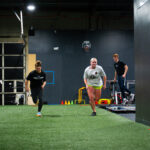Speed and Agility Training for Total Body Fitness
Speed and agility training isn’t just for athletes. It’s a powerful way to improve your overall fitness, coordination, and body control. Whether you’re chasing after your kids, climbing stairs with ease, or looking to improve your gym performance, these drills make you faster, sharper, and more efficient.
What Is Speed and Agility Training?
Speed and agility training involves exercises that enhance your ability to move quickly and change direction efficiently. It develops fast-twitch muscle fibers, boosts coordination, and increases cardiovascular endurance.
Unlike traditional cardio or strength training, agility workouts challenge both the brain and body. You’re not just moving—you’re reacting, adjusting, and staying in control.
Why You Should Add Agility Training to Your Routine
Even if you’re not training for a sport, agility work can benefit you in countless ways:
1. Improved Functional Fitness
Agility helps with real-life movement patterns like bending, twisting, and stepping. You’ll move better in daily life.
2. Better Balance and Stability
Fast-paced movement strengthens stabilizing muscles, reducing your risk of falls or missteps.
3. Enhanced Reaction Time
Agility drills challenge your brain-body connection, sharpening your ability to react quickly and stay alert.
4. Increased Fat Burn
Because agility workouts are fast-paced and intense, they burn more calories than standard steady-state cardio.
5. Injury Prevention
By training your body to move safely and efficiently, agility work lowers the risk of muscle strains and joint issues.
Popular Speed and Agility Drills Anyone Can Do
These drills are accessible for most fitness levels and don’t require much equipment:
Ladder Drills
Use an agility ladder to work on foot speed and coordination. Try high knees, in-out hops, or lateral runs through the ladder.
Cone Drills
Set up cones and sprint, shuffle, or backpedal between them. The variety builds agility and cardio endurance.
Jump and Stick
Perform small jumps in all directions, pausing to “stick” the landing. This enhances balance and body control.
Dot Drills
Use five floor markers (or just spots on the ground) and quickly hop between them in various patterns. It’s a great coordination booster.
You can read more about the science behind agility training on Healthline.
Weekly Speed and Agility Training Plan for Fitness
Here’s a basic schedule you can use alongside your current workout routine:
-
Monday: Ladder + cone drills (30 minutes)
-
Wednesday: Jump and stick + dot drills (25 minutes)
-
Friday: Full-body strength + 10 minutes of agility sprints
-
Saturday (Optional): Outdoor agility circuit (cones, steps, hills)
Always begin with a dynamic warm-up and end with mobility work to stay safe and flexible.
Common Mistakes to Avoid
Getting the most out of agility training means avoiding a few common errors:
-
Skipping warm-ups or cool-downs
-
Prioritizing speed over proper form
-
Ignoring rest days or doing too much too soon
-
Failing to challenge yourself with new drills or variations
Proper form is crucial. Moving fast incorrectly won’t make you faster—it might just lead to injury.
Combining Agility With Other Workouts
Agility training pairs well with:
-
Strength training: Improves power and force output
-
HIIT: Adds variety and intensity to your cardio
-
Mobility work: Keeps joints flexible for faster movement
-
Core training: Builds stability for better balance and control
At Next Level Athletics USA, agility work is often integrated with other training styles to create well-rounded programs that build strong, athletic bodies.
Who Can Benefit From Speed and Agility Training?
Literally everyone.
-
Parents: Keep up with your kids and avoid nagging aches
-
Busy professionals: Boost energy and coordination without long workouts
-
Seniors: Maintain balance and mobility
-
Lifters and runners: Increase stability and prevent overuse injuries
Speed and agility training is low-barrier, high-reward fitness that adapts to any goal.
Final Thoughts
Speed and agility training is one of the most overlooked yet powerful tools in fitness. It builds strength, endurance, coordination, and balance—all in short, efficient sessions.
Whether you want to move better, react faster, or simply feel more athletic, agility work will get you there. Stay consistent, challenge your limits, and you’ll see real improvements both in and out of the gym.


Recent Comments